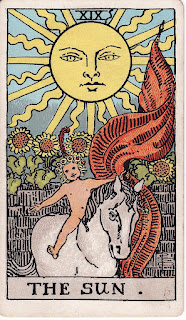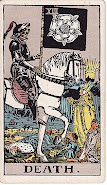Cups
Element: Water
Energy: Feminine
Astrological correspondences: Cancer, Scorpio, Pisces
Time Frame: Weeks to months
Symbolism: Cups represent emotions, relationships of all kinds, family, friends, coworkers, business partners; support groups, and other special interest and niche group gatherings. Any agreements, partnerships, and mergers. The suit of cups also symbolizes the imagination, movies,. All the feelings. Memories, dreams, daydreams. Falling in love, starting a family, a new addition to the family. Hopes and wishes. Being stuck in the past. There can be confusion, misunderstandings, not being able to see a situation clearly or the situation has not being fully revealed. A need to look more deeply into a situation. A mystery. A need for space and reflection, without the pressures or demands of other people. Sorrow, guilt, feeling overwhelmed.
Psychological Conditions: Cups can point to mood disorders, different levels of grief, childhood trauma, dysfunctional family systems, illusions, hallucinations and all forms of escapism. Projection of what's going on in the self onto The Other. Substance use/abuse. Emotional dysregulation
Personality: Cups people can be charming, caring, empathetic, nurturing, and sentimental. They are described as protective, loving, generous and accommodating. They can have a naturally understanding nature and make people comfortable and cared for. They can also be daydreamers who accomplish nothing, drug/alcohol addicts, overly dramatic or conversely; unable to process their emotions or they block their feelings, and hide from emotional situations. They can be cold, unemotional individuals who deliberately choose not to connect with others as a way to manipulate. The can be neglectful, yet overbearing, violating other boundaries. Also thought of as people pleasers, doormats, naïve, and childish - refusing structure. These are the types of folks that like to have pity parties and who strive to win the Sympathy Olympics - meaning that whatever someone else is going through, they need to make their situation sound even more dramatic and alarming. The can be quite deceptive, hiding things from others, and in the case of some severe trauma, hiding things even from themselves. The fulfillment, the neglectment, the abandonment, or disappointment of all emotional attachments.
Special Note: The Law Of Attraction works through feeling and belief. You attract according to you point of attraction, which is determined by how you feel and believe about yourself and the world around you. There's a quality in the Cups that can be misunderstood and that is the Hopes and Wishes. Some people consider hopes, wishes, daydreaming and so forth as a waste of time, and may write off the things they desire to do or have as a pipe dream. But it's entirely possible that the Soul is giving insight into what can manifest for the person, if they put forth the effort to achieve. While visioning, vision boards and using active imagination are incredibly helpful toward meeting the desired goal, it will remain in the imagination unless there is some real world activity. Then even the most fantastical things can come into realization. 💫💫💫























